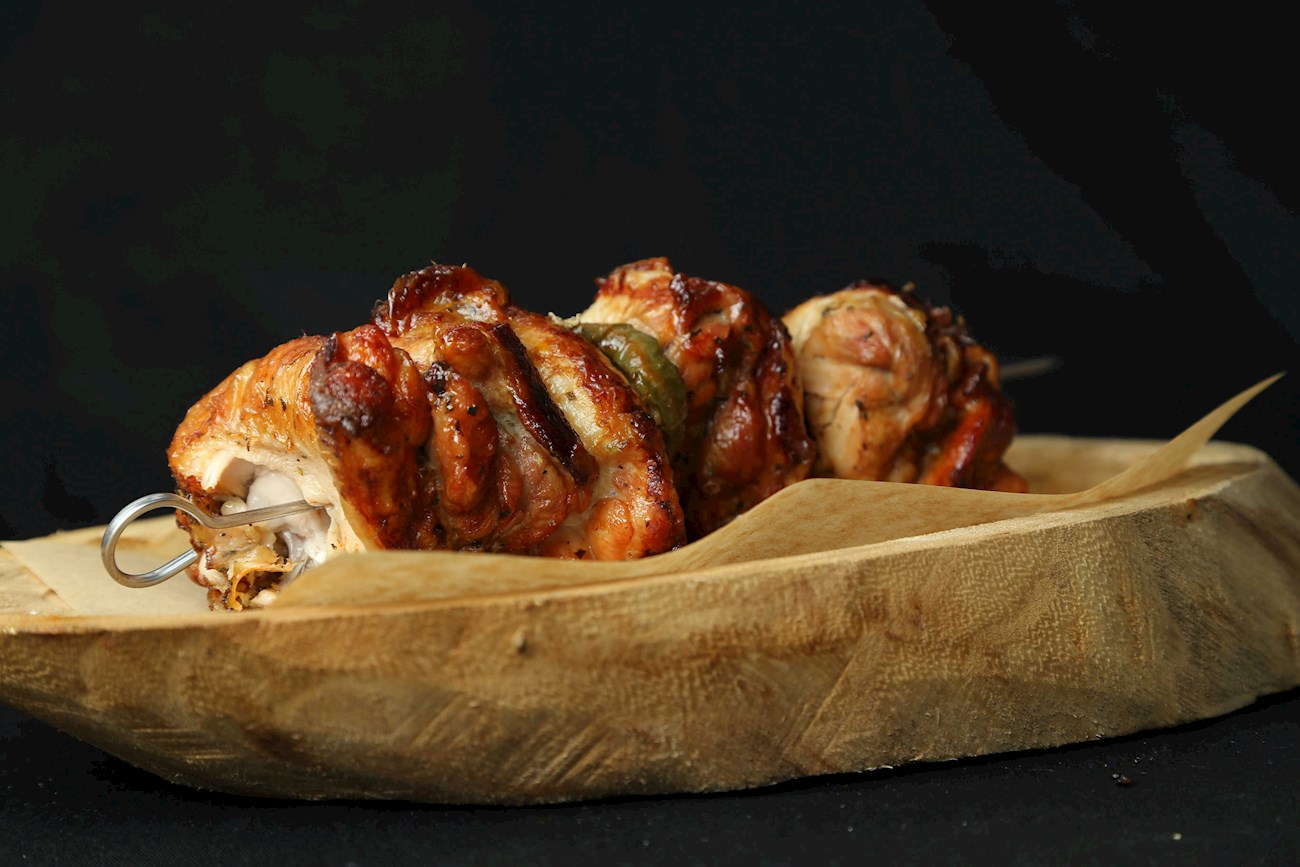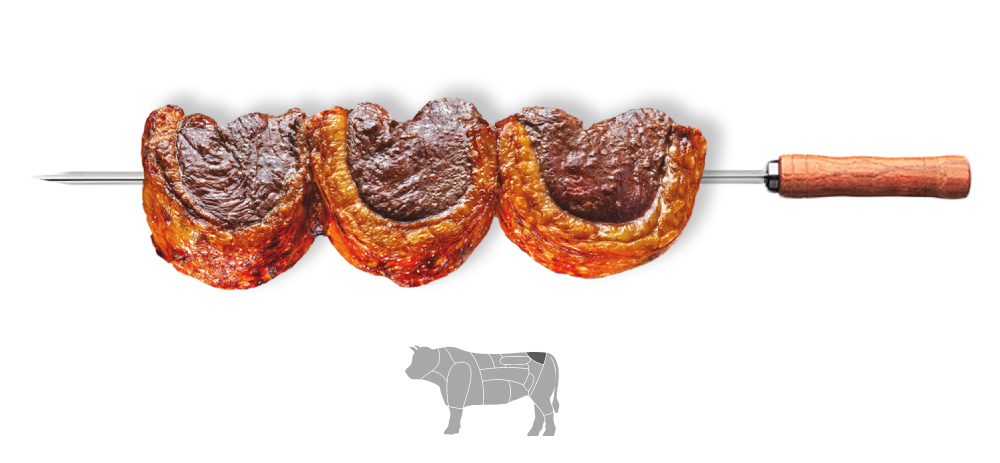MAIN INGREDIENTS
Picanha is a fresh cut of beef that's especially popular and highly prized in Brazil. In the US, it's called sirloin cap, and in the UK, it's known as the rump cap. Picanha is situated on the back side of the animal, above the butt, where it sits on a fat cap.
It's mostly used for churrasco – the meat is first grilled, then sliced off of a skewer. This cut holds very little fat in the meat, so it must be cooked perfectly in order not to make it tough. In Brazil, every churrasco has picanha, and all of the best churrascarias feature picanha on their menus.
MOST ICONIC Picanha
View moreMAIN INGREDIENTS
Kontosouvli is a traditional dish consisting of large pieces of pork marinated in a mixture of herbs and spices, then skewered and slowly cooked on a rotisserie, much like a gyro or souvlaki. The marinade often contains ingredients such as garlic, oregano, thyme, rosemary, paprika, olive oil, lemon juice, and red wine.
After marinating, the meat is threaded onto a large skewer and roasted over an open flame, which results in a rich and flavorful outer crust with a juicy, tender interior. The cooked meat is typically served in thick slices, often accompanied by pita bread, tzatziki sauce, and horiatiki salad, among other possible accompaniments.
MAIN INGREDIENTS
Tire köftesi refers to a special type of ground meat dish that originates from the Tire district of İzmir, Türkiye. Tire köftesi consists of minced meat (often lamb or a mix of beef and lamb), breadcrumbs or stale bread soaked in milk or water, onions, garlic, and various spices.
One distinguishing feature is its soft and juicy texture, which is achieved through its specific mixture of ingredients and cooking method: they are often shallow-fried until they have a crispy exterior, then they might be simmered in a sauce or served directly.
Considered an epitome of Argentinean gastronomy and culture, asado (lit. roast; roasted) is much more than merely a meal. In Argentina, Chile, Uruguay, Paraguay, and in a number of other South American countries, it is both a culinary and social event attended by friends and family to share the joy of outdoor cooking.
Asado traditionally features a wide selection of grilled meats, mainly beef, which Argentina is most known for. The meat is cooked on a special brick-built grill called la parrilla, and the fire can either be made with charcoal (parrilla al carbón) or wood (parrilla a leña) which is more typical for the countryside and known as asado criollo, a term that indicates a more rustic, traditional style of grilling.
VARIATIONS OF Asado
MOST ICONIC Asado
View moreMAIN INGREDIENTS
Contrary to popular belief, the word Châteaubriand does not refer only to a cut of beef, but to a method used to grill or roast a thick cut of beef tenderloin. The steak was originally prepared by a chef named Montmireil in 1822 for a French author, diplomat, and statesman Francois René Vicomte de Chateaubriand.
When served in France, Châteaubriand will always be accompanied by a sauce – most often either a traditional red wine sauce or Béarnaise sauce. The steak is usually served with a side of roasted new potatoes or tiny chateau potatoes.
MOST ICONIC Châteaubriand
View moreMAIN INGREDIENTS
Carne asada tacos are the first tacos in history. It is believed that the first tacos appeared in the 1500s, made with thin slices of meat cooked over hot coals. The meat was placed in a corn tortilla and topped with guacamole, onions, chili peppers, and lime – also known as the carne asada taco.
Over time, people started to make other versions in different regions, and nowadays we are witnessing a true taco-mania, and it all began with the simple carne asada tacos.
MOST ICONIC Carne asada tacos
View moreMAIN INGREDIENTS
In the 1970s and 1980s, the fried chicken industry in South Korea expanded with the emergence of various fried chicken restaurant chains. These chains started experimenting with different flavors and sauces, moving beyond the original, stripped-down version of fried chicken.
Gringas is a typical Mexican dish made with flour tortillas filled with al pastor marinated pork meat, cheese, and, most commonly, pineapple slices, although onions, chili sauce, and coriander can all be added to the dish according to the customer's preference.
The combination of these ingredients is then grilled in the same manner as a quesadilla. The tortillas are usually folded in half and consumed like a taco. The name of the dish, a feminine form of gringo, is believed to have come from the idea that flour tortillas are more popular than corn tortillas north of the Mexican border.
MOST ICONIC Gringas
View moreShashlik is the name for a traditional Central and West Asian barbecue consisting of marinated, skewered, and grilled chunks of meat such as lamb, beef, or pork, depending on regional and religious preferences. Lamb, beef, or pork is usually combined with chunks of vegetables such as bell peppers, onions, mushrooms, or tomatoes.
The meat is typically marinated overnight in vinegar, herbs, spices, and dry wine. In Russia, barbecue is traditionally reserved for men, who are in charge of the whole grilling process, while the women are usually busy slicing vegetables and setting the tables.
MOST ICONIC Shashlik
View moreCochinita pibil is a Mexican pork dish originating from Yucatan. Pork is marinated in a combination of annatto paste, bitter orange juice, and garlic. It is slowly baked and then shredded and served on tortillas, tacos, or on its own with shallots, pickled onions, salsa, and various roasted vegetables.
Cochinita pibil is characterized by the red color of the meat, imparted by the annatto seeds from the marinade. Originally, pork was wrapped in banana leaves prior to baking, but today a foil or any other suitable wrapping can be used instead. Since cochinita means baby pig, and pibil means buried or underground, it acts as a proof that the original recipe used a whole suckling pig that was buried in a pit for roasting.
MOST ICONIC Cochinita pibil
View moreTasteAtlas food rankings are based on the ratings of the TasteAtlas audience, with a series of mechanisms that recognize real users and that ignore bot, nationalist or local patriotic ratings, and give additional value to the ratings of users that the system recognizes as knowledgeable. For the “Top 100 Meat Dishes in the World” list until February 13, 2025, 101,565 ratings were recorded, of which 62,347 were recognized by the system as legitimate. TasteAtlas Rankings should not be seen as the final global conclusion about food. Their purpose is to promote excellent local foods, instill pride in traditional dishes, and arouse curiosity about dishes you haven’t tried.


























































































































